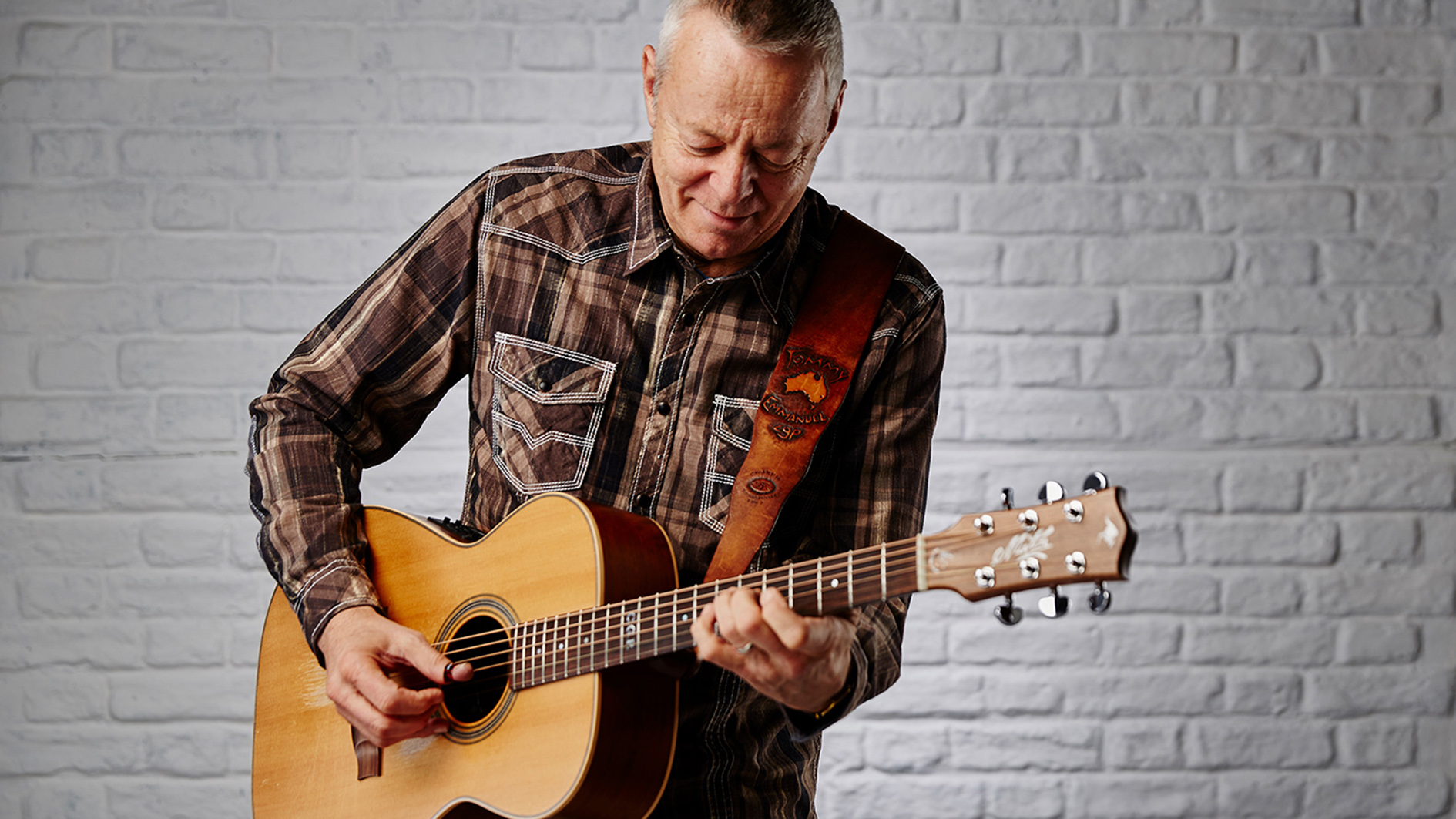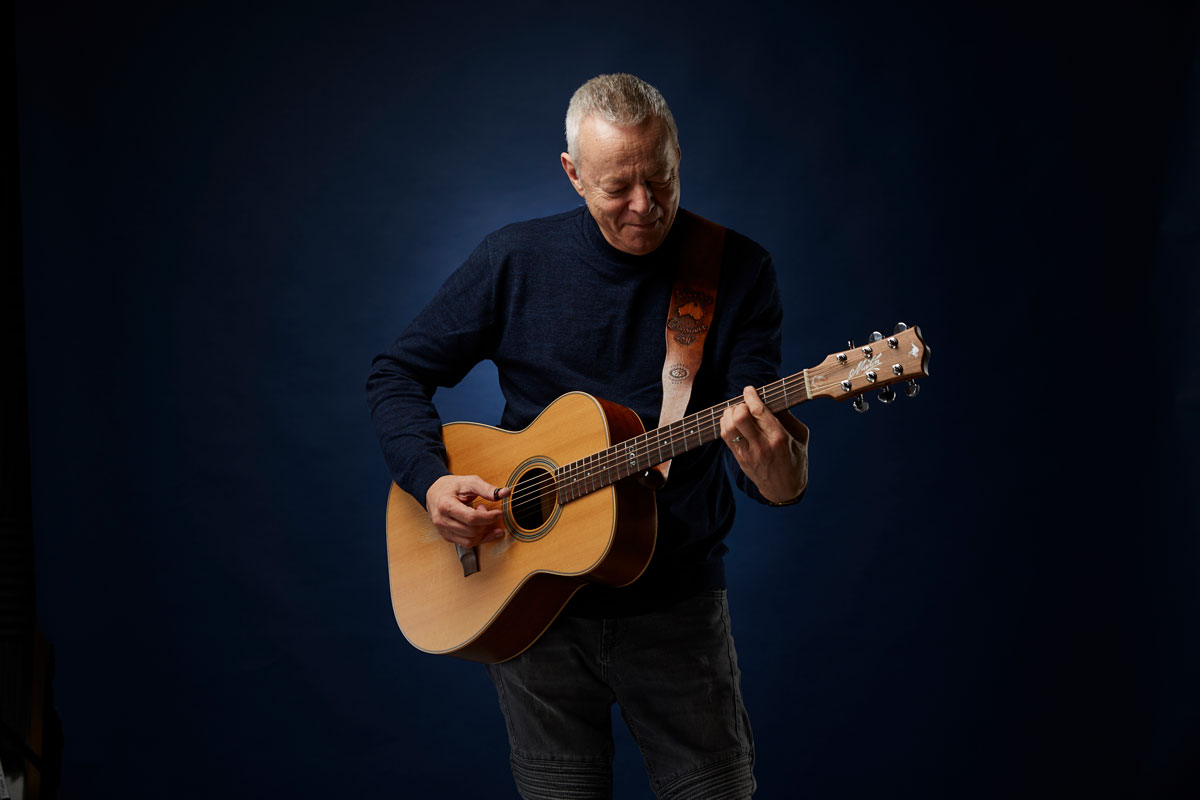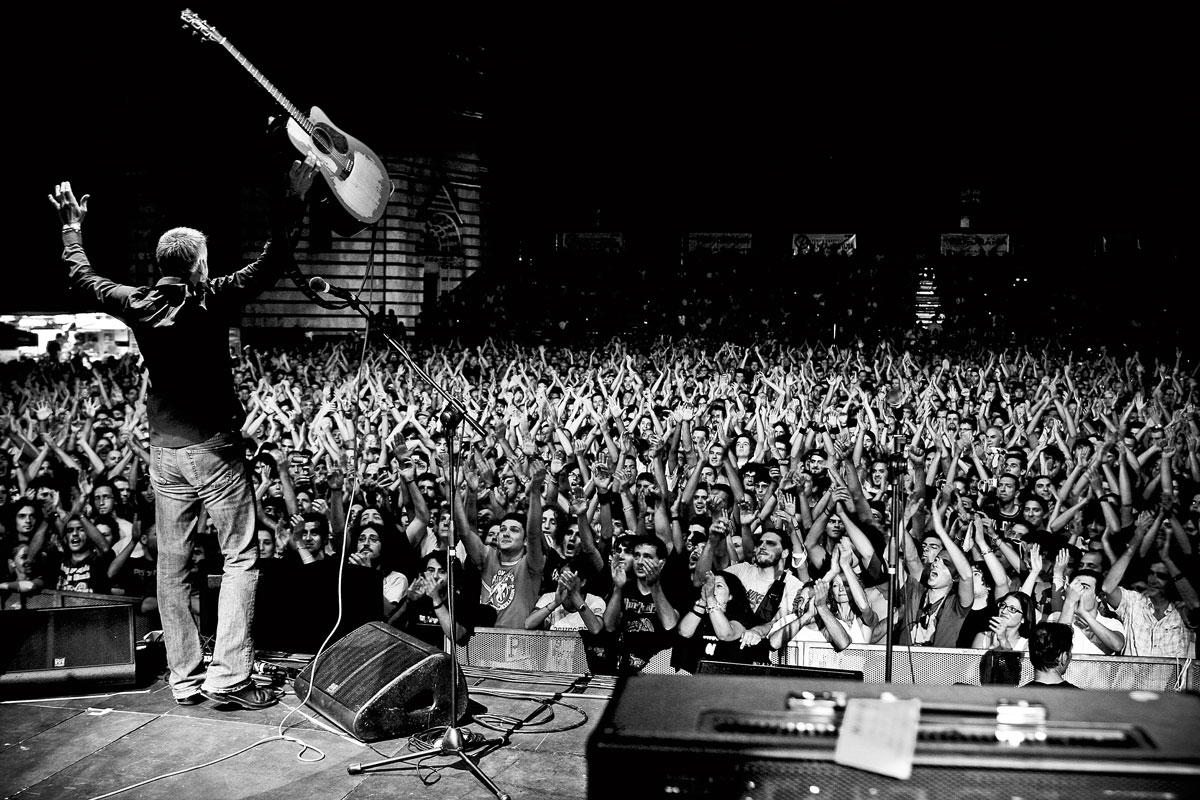Tommy Emmanuel: "You don’t have to fill up every millisecond with sound and noises - I let the audience fill in the gaps"
The Australian fingerstyle maestro on technique, leaving something to the imagination, and why the story is the most important thing

Tommy Emmanuel is freezing his ass off outside a coffee shop in Nashville, Tennessee, ostensibly so he can promote his upcoming show in Orange, California, at the Musco Center for the Arts, which takes place on December 10, and for which you can buy tickets here.
But mostly because we couldn’t resist the opportunity to pick the brains of a player whose approach to the acoustic guitar is truly awe-inspiring.
Emmanuel is a phenomenon, a maverick. There are few, if any, better fingerstyle players on the planet. His style is descendent from the work of Chet Atkins, with whom he collaborated on The Day Finger Pickers Took Over the World, in 1997, and yet it is entirely his own.
With Emmanuel, the style never gets in front of the idea. Songwriting is storytelling, whether there are lyrics or not, he says, and players have to give the audience just enough room to exercise their imaginations. That, he says, is part of the magic of songwriting.
Next year will see the release of a double-album of 26 original compositions, many of which he will be debuting on this December tour through California. It follows Heart Songs, which was recorded with John Knowles and released in January this year.
Covering the likes of Hank Williams and the Bee Gees will make this a fascinating release, and it’s similarly intriguing to hear Emmanuel’s thoughts on how to reinterpret a song for acoustic guitar, and what makes a good cover.
It’s funny - Emmanuel says he can’t read music, but he sure can read a room, and his insights into what the audience want are as good an example of songwriting wisdom as you will read today...
Get The Pick Newsletter
All the latest guitar news, interviews, lessons, reviews, deals and more, direct to your inbox!
We’ll start with the easy ones, Tommy – what guitars are you playing at the moment?
“My three Maton guitars that I travel the world with. That’s what I’ll be playing. They are three Custom Shop Maton guitars, made in Australia.”
Do you still keep them in different tunings?
“My main guitar is in normal guitar tuning, and then one of the other ones is in a drop D tuning but it’s down a whole tone, so it’s down to drop C. And that has the big medium strings on it.
When you are playing an instrumental it has to be interesting, have movement, and tell a story without words
"Then the other guitar goes between a drop D tuning and an open G tuning, depending on what songs I want to play. And the reason I have three guitars is because I have them pre-tuned so there is no putting my guitar in and out of different tunings all the time. I want to be perfectly in tune.”
What is your approach to alternate tunings?
“I put my guitar in the tuning that is appropriate to the song. That is all I can say on that. [Pauses] No, playing in drop D is nice because you have got that nice low bass, and it just gives you a wider tone band to work with, and that low string can be a beautiful effect. And even when you capo up with the drop D it still sounds big down the bottom.”
You made some really interesting song choices on Heart Songs. What draws you to a cover?
“When you are playing an instrumental it has to be interesting, have movement, and tell a story without words. So that is what I am looking for. If I am going to do a cover of a song, I still try to make it my own. I try to take someone’s work and give it my own voice, and people always say to me, ‘Oh, why don’t you do Blackbird? Why don’t you do blah blah blah?’
"Certain songs such as Michael Jackson’s Beat It, or Thriller, or something like that, and those things don’t work as instrumentals. They work when Michael Jackson sings them, but they don’t work as an instrumental."
“I am very careful. I have really got to be in love with a song to want to make a cover of it, and that is the reason why the Beatles songs that I do - Lady Madonna, and Day Tripper - because they are monumental challenges to try and work out where all the parts go at once.
"But that stuff really works. It tells the story. It lays it all out. And I can show people, ‘Well here’s the bass part, here’s the piano part, and here’s the vocal part, and now I am going to put them all together and do it all at once.’ And that’s what amazes people, but also there is a lot of good stuff in those songs. I did that because it was a unique thing, and I didn’t see anyone else doing it. That is why I did that in the first place.”
It is amazing to hear the Bee Gees’ How Deep Is Your Love arranged for acoustic. There are so many melodic elements to incorporate.
“I didn’t try to put too much in there. I just listened to the actual melody, of what Barry [Gibbs] was singing, and I just took that, rather than trying to put in all the other stuff that the brothers sing. I just stuck with the melody, and I find that that worked.
"If I start chasing a lot of stuff then instrumentally it is going to sound like a science experiment, and I don’t want that. That’s why there are certain people out there in the guitar world, playing covers, who are trying to cover all the parts at once, and when you watch them play it there is a lack of feeling because there is too much going on and they are trying to cover everything.
“I call it a science experiment. It’s like a juggler and a card dealer all working at once and it is just too much. Y’know, just tell me the story, and lay it out for me. That’s what I am looking for. Growing up listening to Chet Atkins taught me to find the melody and stick with the melody.”
Absolutely. Like you say with the science experiment, you’ve almost got to leave yourself a little spare capacity in your playing ability so that you can enjoy the performance, and to perform.
“I think so. Plus, you’ve got to leave something for the imagination, and for people to fill in the gaps themselves, y’know.”
That is really interesting. Is that something you think of when you are composing?
“Of course. I think the way people are nowadays, because of technology and iPhones and computers and everything, people want everything and they want it all now, and that is not how life works.
I play the melody like I am singing it a cappella and let the audience fill in the chords with their minds. They are hearing the chords in their imagination.
"You don’t have to fill up every millisecond with sound and noises. I remember when I had a young guy, I won’t say his name, but a young guy I admire very much on the road with me, and he was opening. He was a young teenager and he was playing his heart out, and really giving the audience 35 minutes of everything he had, and I said to him one night, ‘Y’know, you could just put one slow song in your show just to give the people a break from constant, full-on, everything going. Why don’t you just play one ballad.’ And he said to me, in all honesty, he said, ‘I am so afraid of the space between the notes.’
“I realized that’s what it was; he is from this younger generation, so they are afraid to just be, and to just let things hang, whereas he would watch me play and say, ‘I wish I could play ballads like that but I am so afraid.’ I admired his honesty, but I learned a kind of clarity from that, that younger people, everything has to be moving and full of action, and full of stuff all the time otherwise they lose their attention.
“A guy my age is the opposite of that. That’s why you see great art, great movies, and there is a lot of action, but there are some where there are five minutes of stuff that is so subtle that it gives you a chance to watch it and be, and almost be a part of it.
"I think, musically, I try to let people do that. Like sometimes I’ll break into a tune like What a Wonderful World, because everybody knows that song. I don’t play the chords. I just play the melody like I am singing it a cappella and let them fill in the chords with their minds.
"They don’t know I am doing that but that is what I am doing. I am just singing the song to them and they don’t even realize; they are hearing the chords and it is their imagination.”

Sometimes we need reminding that the space between the notes is the music.
“Totally. It’s the same thing with our thoughts. Thoughts come and go and our minds are active because we are either always on the phone or we are doing something, and there has to be times where we just stop and give our consciousness a break.
"And it’s the same thing [with music]. I find that if I get an idea to write a song, if I am inspired - and I really can’t write it if I am not inspired - I know I don’t think about anything else, only this idea that I’ve got, so that nothing comes in and sweeps it away and clouds my thoughts. I just stick with what I am doing so that it is one thing at a time that is important to me, and that’s it.
“I think that principle works for the public, because I can play a million things and be improvising and jumping around, and blowing their minds, entertaining them, but there has to a break from that, and that’s when, say I’ve done that for three songs and the audience are on the edge of their seats, then I’ll play something really soft and simple, and it gives them a chance to just sit back and relax, and let it just wash over them. That is all part of it.”

It is like you said earlier there, about telling the story, that is part of the story, and even with acoustic instrumental music, it is all storytelling.
“Oh it is, definitely. Yeah, well a lot of young guys who are big into songwriting now are eager to impress everyone, and so they are writing stuff that’s really just a lot of chords moving around with a groove, and I am waiting for them to tell me a story. And they don’t know that.
"They think that songwriting is about creating a structure and making it really fantastic, and moving all the chords around and all that, and it’s like, ‘Hang on a second! You are not telling me a story and you are not moving me emotionally. Take me somewhere. Tell me something.’ That’s what I am waiting for. When I hear someone who does that I am excited because, yes, they have got it.”
There’s no better gift than someone creating an atmosphere, an emotional range, or a story to inhabit for an hour or so...
“Oh yeah, and you’ve got to remember it as well! I hear a lot of young composers writing things and there is so much going on that I can’t remember any of it. All I want to do is stop them, take away half of that, say half as much so I can have a chance to get onto it and get it into my head.
"You’ve really got to think about that, and you’ve got to say something and create an emotion that moves people, that they can hook onto straight away.”
Does the acoustic guitar lend itself to a more individualist style? Because, in a sense, you are trying to do more with less...
There are two songwriters inside me. One in my head that is full of ideas, and one deep in my heart that has to be satisfied, and that is the one that always wins
“I think it really comes down to what you have got to say. For myself, I like both; I like the electric guitar and the acoustic, but I mostly write on acoustic - even back in the ‘80s when I was playing electric mostly I was still songwriting on the acoustic because it has got to stand up on that.
"There’s no frills, y’know, and so I used to try and write on the acoustic so that it was sort of chiseled, the melody was chiseled in stone, and that’s what I was trying to achieve there.
“Everybody has their own way of doing it, and I don’t think my way is right or wrong - it is just how I do it and it works for me. You may have a completely different approach and that’s your way.”
True. Everyone has their own style...
“Hearing Billy Joel talking about his songwriting, he said, ‘Well I like to tell a story musically first, and then I find the words second.’ So, y’know, he does that.
"John Lennon used to write down poetry, and write down words - he could be at dinner and he would get an idea and he’d write words down and put music to it later. So Lennon was the opposite. Everyone has their own approach.”
There is an immediacy with the acoustic that let’s you know when something isn’t working.
“Also you have to have your quality control going, and I certainly have that. There are two songwriters inside me. There is one inside my head that is full of ideas, and then there is one deep in my heart that has to be satisfied, and that is the one that always wins. But the guy in my head will come up with a thousand ideas until the guy in my heart says, ‘No more, no less, just that.’ That’s my quality control.”
Your technique is formidable. Is there any aspect of your playing that you worry about?
“I don’t worry about anything. No, I work on it, I work on what I need to be better at. I go through periods of practicing strength, skills, things like that, but mostly when I practice I usually play songs as if people are listening and that is what makes me a better player; playing the songs. I know my strengths and my weaknesses, so I know what I need to work on, and I approach it that way.”
Nothing inspires a better performance than knowing - or thinking - that someone is listening.
“Oh, totally. Totally. I play like this is the last time I am going to play, all the time. I don’t know any other way. I’m just following my own instincts and trying what works for me.”
Jonathan Horsley has been writing about guitars since 2005, playing them since 1990, and regularly contributes to publications including Guitar World, MusicRadar and Total Guitar. He uses Jazz III nylon picks, 10s during the week, 9s at the weekend, and shamefully still struggles with rhythm figure one of Van Halen’s Panama.
“It was tour, tour, tour. I had this moment where I was like, ‘What do I even want out of music?’”: Yvette Young’s fretboard wizardry was a wake-up call for modern guitar playing – but with her latest pivot, she’s making music to help emo kids go to sleep
“There are people who think it makes a big difference to the sound. Stevie always sounded the same whether it was rosewood or maple”: Jimmie Vaughan says your fretboard choice doesn’t matter – and SRV is his proof








![John Mayer and Bob Weir [left] of Dead & Company photographed against a grey background. Mayer wears a blue overshirt and has his signature Silver Sky on his shoulder. Weir wears grey and a bolo tie.](https://cdn.mos.cms.futurecdn.net/C6niSAybzVCHoYcpJ8ZZgE.jpg)

![A black-and-white action shot of Sergeant Thunderhoof perform live: [from left] Mark Sayer, Dan Flitcroft, Jim Camp and Josh Gallop](https://cdn.mos.cms.futurecdn.net/am3UhJbsxAE239XRRZ8zC8.jpg)
